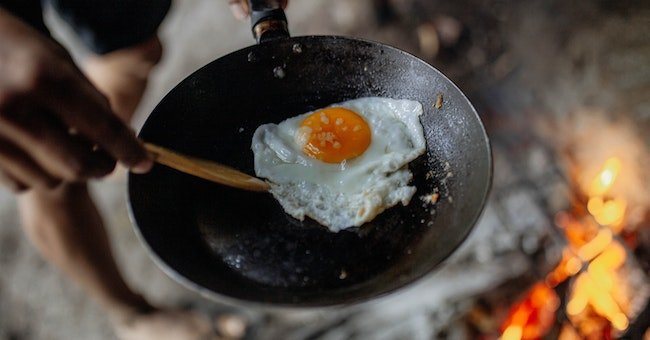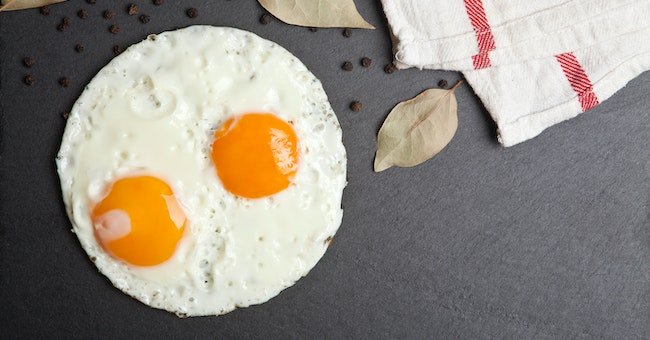Fried Egg Vs. Sunny Side Up
It’s sunny and bright. Eggs are cooked with the yolk in place and aren’t flipped. Oversimplified: the egg has been turned over, and the yolk is running. Medium: The egg is turned upside down, and the yolk remains barely runny. In a well, the egg has been turned over while the egg yolk cooks hard.
Fried eggs and sunny-side-up eggs are two well-known cooking techniques that highlight the versatility and simplicity of eggs. Although they have a lot in common, they differ in appearance and cooking techniques.
Fried eggs are an old-fashioned dish wherein an egg is cooked on each side until the whites have completely set and the yolk is cooked to the level you want. To make fried eggs, it is necessary to add a little butter or oil that can be heated up in a pan, and then the egg is cracked straight into the skillet.
The egg is cooked at a moderate temperature and allowed to form and develop a golden brown color at the edge. The yolk is cooked to various levels, from runny to fully cooked. The result is a delightfully crisp-edged egg fried with a soft or creamy yolk, depending on your preference.
The Popularity of Eggs Fried and Sunny-Side-Up Eggs
Fried eggs and sunny-side-up eggs are two well-known cooking techniques that show the versatility and simplicity of eggs. Many people all over the world enjoy them as a great and delectable option for breakfast or brunch.
Universal Breakfast Favorites
Fried and sunny-side-up eggs are becoming popular breakfast options in many cultures worldwide. Their easy cooking and delectable flavor make them ideal for a filling and delicious breakfast. Eggs are regarded as an excellent source of versatile protein, and these cooking techniques permit the taste and texture of eggs to be accentuated.
The popularity of fried eggs, as well as sunny-side-up eggs, is due to their versatility. They can be enjoyed as a stand-alone meal or with various accompaniments like bacon, toast, sausages, or vegetables. They can also be served with sauces, condiments, or even vegetables.
Cultural Significance
Fried and sunny-side-up eggs are associated with cultural significance in various cuisines. In numerous Western nations, including the United States and the United Kingdom, they are an integral element of traditional breakfast menus. They are often served with toast, bacon, and various breakfast options.
In Hispanic and Latino culture, fried eggs are referred to as “huevos fritos” and are typically served with beans, rice, and tortillas as an integral part of a filling meal or breakfast. In Asian cuisines, sun-side-up eggs are usually served alongside noodles, rice, or congee. They add incredible richness and creamy flavor to the food.
Variations in Cooking Techniques
While fried eggs and sunny-side-up eggs are common cooking methods, various ways of cooking and preferences are found across various regions and cultures. Some prefer to fry eggs in butter to add depth, while others use bacon fat to add flavor. The cooking time and temperature may differ, which can affect the consistency achieved by the egg yolk.
Certain people may prefer a slightly runny yolk inside the sunny-side-up egg. However, others might prefer a slightly cooked yolk in a fried egg. The various cooking methods allow for personalization and customization of the food.
Breakfast All Day
The appeal of fried eggs and sunny-side-up eggs goes beyond breakfast time. Eggs are now the most popular breakfast option on all-day menus in diners, cafes, and restaurants across the globe. Due to their versatility and capacity to go well with various ingredients, they are frequently included in lunch burgers, breakfast sandwiches, bowls, salads, and more that cater to people’s desire for relaxing and satisfying food at any time of the day.
Regional and Cultural Twists
Fried and sunny-side-up eggs have been modified and integrated into local dishes and culinary dishes, giving a distinctive flavor to their appeal. For instance, in Mexican cuisine, huevos ranchero is a fried egg dish served with tortillas and topped with beans, salsa, and cheese.
For Turkish food, “mention” is a famous dish made from sunny-side-up eggs cooked with tomatoes, peppers, and spices. These regional variations show the versatility of fried eggs and sunny-side-up eggs for local tastes and cooking traditions.
The Debate About The Two Cooking Techniques
The debate over fried eggs and sunny-side-up eggs is based on individual preferences in cooking techniques and cultural practices. Both cooking methods provide an excellent and diverse way to eat eggs; people generally have strong opinions on their preferred style.
Taste and Texture
The texture and taste of fried eggs and eggs that are sunny-side up are usually at the forefront of debate. Fried eggs with crispy edges and soft as well as firm eggs present an array of different textures that are appealing to a variety of people. Crispy edges offer an interesting contrast to the soft whites and the sweetness in the yolk.
On the other hand, sunny-side-up eggs are renowned for their soft and spongy yolks. The yolk’s runny texture creates a delicious and creamy aspect to the dish and provides an explosion of flavor when paired with various other elements.
Appearance
The appearance of the egg plays an important part in the debate between eggs that are fried and sunny-side-up eggs. Fried eggs have a distinctive and attractive appearance with golden-brown edges and a yolk that can vary from soft to fully cooked. Crispy edges provide an appealing texture to the food.
On the other hand, sunny-side-up eggs offer a stunning display with a cooked white and a sparkling, shiny yolk that rests over the whites and resembles the sun. The look of sunny-side-up eggs usually evokes memories of freshness and a sunny breakfast.
Cooking Techniques and Versatility
The debate about fried eggs and sunny-side-up eggs also centers around cooking methods and the variety they can provide. Fried eggs require turning during cooking to ensure both sides are cooked evenly. Flipping them can result in broken yolks and cause displeasure for those who prefer an egg with a thick yolk.
However, cooking sunny-side-up eggs with only one side of the egg and not flipping them makes an egg that is beautifully round, with the yolk being runny. The power of both techniques is to alter the cooking time and yolk consistency according to your personal preferences.
FAQ’s
What is the difference between a fried egg and sunny side up?
Answer: A fried egg and sunny side up egg are essentially the same in terms of cooking method, but they differ in the doneness of the yolk. A fried egg is cooked on both sides, while a sunny side up egg is only cooked on one side, leaving the yolk runny and intact.
How do you cook a fried egg?
Answer: To cook a fried egg, you crack an egg into a preheated pan with some oil or butter. Allow it to cook on one side until the white is set, then carefully flip it and cook for a short time on the other side until the yolk is fully cooked through.
How do you cook a sunny side up egg?
Answer: To cook a sunny side up egg, you crack an egg into a preheated pan with some oil or butter and let it cook on one side without flipping. The white should be fully set while the yolk remains runny and exposed.
Can you achieve different levels of doneness with sunny side up eggs?
Answer: Yes, you can achieve different levels of doneness with sunny side up eggs by adjusting the cooking time. For a completely runny yolk, cook the egg for a shorter time. If you prefer a slightly firmer yolk, cook it for a bit longer.
What are the typical serving methods for fried eggs and sunny side up eggs?
Answer: Fried eggs and sunny side up eggs are commonly served as a breakfast dish or added as a topping to other dishes like sandwiches, burgers, or rice bowls. They can also be enjoyed on their own with a side of toast or bacon.
Are there regional variations or names for fried eggs and sunny side up eggs?
Answer: Terminology and cooking methods may vary in different regions. In some places, sunny side up eggs may be referred to as “dippy eggs,” “bullseye eggs,” or “eggs over easy.” It’s always helpful to clarify the preferred cooking style when ordering or discussing eggs in different locales.















